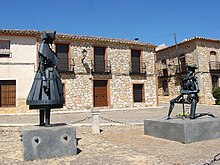
Back Дулсинея Bulgarian Dulcinea Catalan Dulcinea del Toboso German Dulcinea Esperanto Dulcinea del Toboso Spanish Dulcinea Tobosokoa Basque Dulcinea Finnish Dulcinée French Dulcinea del Toboso Italian Dulcinea Dutch
This article needs additional citations for verification. (June 2008) |
| Dulcinea del Toboso | |
|---|---|
| Don Quixote character | |
 Dulcinea (1957), sculpture by F. Coullaut-Valera, in Madrid (Spain). | |
| Created by | Miguel de Cervantes |
| In-universe information | |
| Gender | Female |
| Family | Lorenzo Gonzalo (father) Aldonza Nogales (mother) |
| Religion | Roman Catholic |
| Nationality | Spanish |
Dulcinea del Toboso is a fictional character who is unseen in Miguel de Cervantes' novel Don Quixote. Don Quixote believes he must have a lady, under the mistaken view that chivalry requires it.[1]: 117 [2] As he does not have one, he invents her, making her the very model of female perfection: "[h]er name is Dulcinea, her country El Toboso, a village of La Mancha, her rank must be at least that of a princess, since she is my queen and lady, and her beauty superhuman, since all the impossible and fanciful attributes of beauty which the poets apply to their ladies are verified in her; for her hairs are gold, her forehead Elysian fields, her eyebrows rainbows, her eyes suns, her cheeks roses, her lips coral, her teeth pearls, her neck alabaster, her bosom marble, her hands ivory, her fairness snow, and what modesty conceals from sight such, I think and imagine, as rational reflection can only extol, not compare" (Part I, Chapter 13, translation of John Ormsby).
Don Quixote is portrayed as both admirable ("and doth she not of a truth accompany and adorn this greatness with a thousand million charms of mind!" "that, winnowed by her hands, beyond a doubt the bread it made was of the whitest.") and ridiculous throughout the novel. Sancho knows this, and is enthusiastic for Dulcinea in as much as "if your worship goes looking for dainties in the bottom of the sea".[1]
Dulcinea is based on the Spanish word dulce (sweet), and suggests an overly elegant "sweetness". To this day, a reference to someone as one's "Dulcinea" implies idealistic devotion and love for her.[3]

- ^ a b Eisenberg, Daniel (1987). A Study of "Don Quixote". Juan de la Cuesta. p. 121. ISBN 1588710017.
- ^ Eisenberg, Daniel (2004). "La supuesta homosexualidad de Cervantes". Siglos dorados: Homenaje a Agustín Redondo. Vol. 1. Madrid: Castalia. pp. 399–410. ISBN 849740100X.
- ^ "Dulcinea". oxfordreference.com. Oxford University Press. Retrieved 2020-04-22.